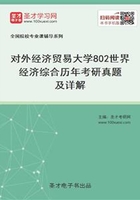
2006年对外经济贸易大学802世界经济综合考研真题
一、单项选择题(6分,每题1分)
1一个在美国工作的中国公民的收入要计入中国的( )。
A.GNP
B.GDP
C.NDP
D.NI
2下列市场中经济效率最高的是( )。
A.寡头垄断
B.垄断竞争
C.垄断
D.双头垄断
3新古典宏观经济学的理论渊源是( )。
A.凯恩斯主义
B.理性预期理论
C.货币主义
D.马克思主义
4下列哪种措施是WTO规则绝对禁止的贸易保护主义措施( )。
A.灰色区域措施
B.反倾销
C.反补贴
D.特保措施
5下列哪个区域一体化组织属于“经济联盟”性质( )。
A.北美自由贸易区
B.欧盟
C.海湾合作委员会
D.东盟自由贸易区
6下列哪个属于农产品的蓝箱政策( )。
A.科研补贴
B.休耕补贴
C.出口补贴
D.虫害防治
二、多项选择题(10分,每题2分)
1下列哪些因素会导致供给的变动( )。
A.生产成本的变动
B.生产技术水平的变动
C.相关商品价格的变动
D.生产者对未来预期的变化
E.需求增加而价格上升
2专向性补贴包括( )。
A.专门用于研究与开发的补贴
B.企业专向性补贴
C.产业专向性补贴
D.地区专向性补贴
E.禁止性补贴
3货币政策的主要形式包括( )。
A.再贴现率
B.公开市场业务
C.变动法定准备率
D.直接控制银行贷款数量
E.道义劝告
4以下哪些是《农业协议》针对的主要农产品政策领域( )。
A.出口补贴
B.政府采购
C.市场准入
D.国内支持
E.卫生检疫
5关于直接投资和跨国公司的理论有( )。
A.垄断优势理论
B.比较优势论
C.市场内部化理论
D.比较利益理论
E.产品生命周期理论
三、名词解释(24分,每题4分)
1保障措施
2“经济人”假设
3转移支付
4实际汇率
5自由贸易区
6世界经济
四、简答与计算(40分,每题8分)
1在新古典增长模型中,人均生产函数为y=f(k)=2k-0.5k2,人均储蓄率为0.3,设人口增长率为3%,折旧为零,求:
(1)使经济均衡增长的k值;
(2)黄金分割律所要求的人均资本量。
2什么是帕累托最优?交换、生产以及交换和生产的帕累托最优条件分别是什么?
3已知某企业的生产函数为Q=L2/3K1/3,劳动的价格w=2,资本的价格r=1,求:
(1)当成本C=3000时,企业实现最大产量时的L、K和Q的均衡值;
(2)当产量Q=800时,企业实现最小成本时的L、K和C的均衡值。
4简述生产要素禀赋论。
5简述亚太经合组织(APEC)的特点。
五、论述题(30分,每题15分)
1试析2005年以来中国与美欧纺织品贸易争端的背景、谈判结果及其意义。
2试析人民币升值对中国经济的影响。
六、专业英语试题(英译汉,共40分,每题20分。要求:汉语译文字体工整、措辞及标点符号准确)
1Assessing the implications of a major economy-wide reform such as that involved in China’s WTO accession is inherently difficult. The experience with other trade events such as the formation of NAFTA suggests that the actual overall impact will be much greater than suggested by ex ante modeling, largely as a result of productivity and other changes that are hard for models to capture. Analysis indicates that China’s clothing production could more than double, and its textile production expand by nearly 50 percent, as a result of WTO accession combined with the proposed phase-out of quotas as part of the Agreement on Textiles and Clothing. These estimates, however, omit some important potential elements of trade policy, namely, the application of antidumping and safeguards measures against China and the possibility that China itself will increasingly apply such measures. One feature of the accession agreement is the Product-specific Transitional Safeguard Provisions, lasting over a 12-year period, which may be applied to China by any member and may then trigger actions against the diversion of Chinese exports to other markets, with special textile safeguards for three years. Similarly, as regards antidumping provisions, China will potentially remain vulnerable for up to 15 years to non-market economy provisions that dramatically increase the probability of dumping being found and the relevant antidumping duties being applied. China’s own increased use of antidumping and safeguard measures would be legal and consistent with the rules-focused approach to WTO implementation.(20分)
2By almost all accounts, foreign direct investment (FDI) in China has been one of the major success stories of the past 10 years. Starting from a base of less than $19 billion in 1990, the stock of FDI in China rose to over $300 billion at the end of 1999. Ranked by the stock of inward FDI, China thus has become the leader among all developing nations and second among the APEC nations (only the United States holds a larger stock of inward FDI). China’s FDI consists largely of greenfield investment, while inward FDI in the United States by contrast has been generated more by takeover of existing enterprises than by new establishment. The majority of FDI in China has originated from elsewhere in developing Asia (not including Japan). Hong Kong, now a largely self-governing “special autonomous region” of China itself, has been the largest source of record. The dominance of Hong Kong, however, is somewhat illusory in that much FDI nominally from Hong Kong in reality is from elsewhere. Some of what is listed as Hong Kong-source FDI in China is, in fact, investment by domestic Chinese that is “round-tripped” through Hong Kong. Other FDI in China listed as Hong Kong in origin is in reality from various western nations and Taiwan that is placed into China via Hong Kong intermediaries. Alas, no published records exist to indicate exactly how much FDI in China that is nominally from Hong Kong is in fact attributable to other nations.(20分)